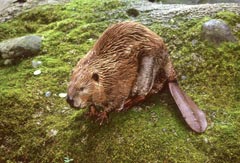AARP Hearing Center
5 Gross Things You Didn't Know Were in Your Food
By Candy Sagon, October 28, 2013 07:00 AM
It's amazing what food labels don't tell you. For instance, what exactly is "natural flavoring" or a mysterious ingredient like L-cysteine? And then there are the things that aren't even listed on the label that are even more worrisome. Here are some of the hair-raising things that might be in your next bite of food.

Castoreum. This is one of those "natural flavoring" additives. It comes from the scent glands of a beaver, which are located near the anus. (Yes, beaver butts.) It's primarily used in perfume but also as a substitute for vanilla, strawberry or raspberry flavor in candy, gum, gelatin and pudding. Bad news for vegans, vegetarians, animal rights activists and those of us who are easily grossed out.
Sign up for the AARP Health Newsletter .
Antibiotics. You take antibiotics to fight off infection, but animal producers use vast quantities of medically important antibiotics to quicken animal growth. This overuse then causes bacteria strains to develop that are drug-resistant. When people get sick, say from bacteria-contaminated food, it's much harder to fight off the disease. Despite years of criticism for their overreliance on antibiotics, meat producers haven't changed their ways, a new Johns Hopkins University study found- in fact, in some ways things have gotten worse, researchers said. A recent salmonella outbreak on the West Coast from contaminated chicken, for example, was linked to a more powerful strain that caused twice the usual rate of hospitalization.
Bug parts. Hope this doesn't bug you, but insects play a big role in making food look pretty. For instance, the female Lac bug from Asia excretes the shellac that makes jelly beans and other candies shiny. And carmine (often referred to as Natural Red 4 in the ingredient list) is a red food coloring that comes from boiled cochineal bugs. It gives a rosy hue to products like yogurt, syrup, ice cream, candy, pink lemonade and grapefruit juice. Carmine has been reported to cause serious allergic reactions in some people, and Starbucks said it would stop using it after vegan customers objected. As LiveScience.com pointed out, however, while the idea of using bugs in food may seem gross to some, "if it doesn't come from a bug, it may come from something worse."
Hormones. Cows today produce twice as much milk as they did in 1970. Why? Their feed includes a hormone booster called
Get discounts on health products and services with your AARP Member Advantages.
Human or hog hair and duck feathers. Like your bread all soft and squishy? Thank the dough conditioner L-cysteine, an amino acid derived from human or hog hair, or from duck feathers. Depending on which company you ask, either hog hair or human hair, generally from China, provides most of the L-cysteine, according to a 2011 survey of food-ingredient suppliers by the Vegetarian Resource Group (VRG). There is a synthetic L-cysteine available, but it's much more expensive. The hair or feather variety is cheaper and, as the suppliers told VRG, considered all "natural," compared with the synthetic kind made from chemicals. McDonalds told VRG it uses duck feather-derived L-cysteine in some of its products, like the apple pie. Dunkin' Donuts also said it uses the kind made from feathers. To avoid the additive, just check the ingredient list.
Photo: Bob Bennett/Getty Images

Also of Interest
- Ready-to-Eat Salads With Meat Recalled for Listeria
- 4 Surgeries to Avoid
- Shopping for health insurance? The health insurance marketplace is now open
- Join AARP: Savings, resources and news for your well-being
See the AARP home page for deals, savings tips, trivia and more































































